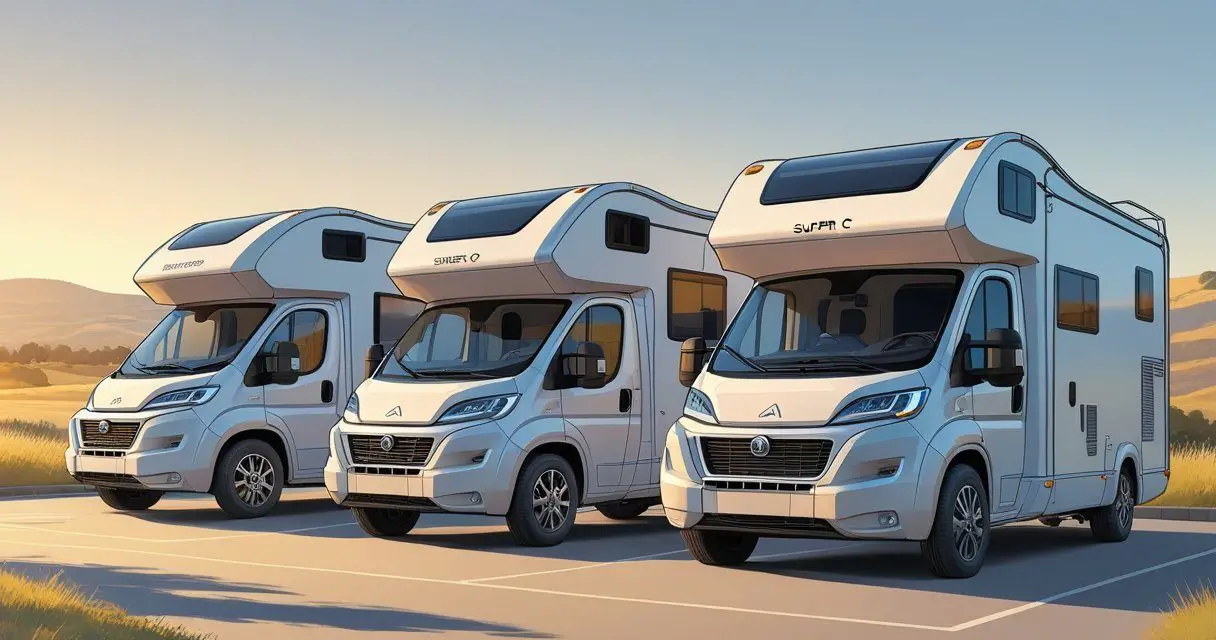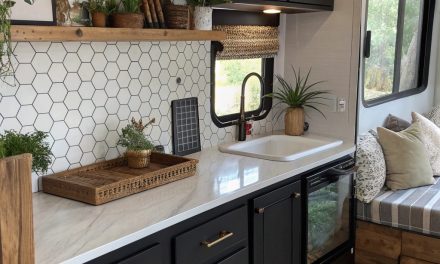Would you like to save this article?
When you’re shopping for your dream Super C motorhome, you’d think the biggest one with the most storage would be the obvious winner, right?
Wrong. The reality of RV living is far more complex than what looks good on paper or during a quick walkthrough at a dealership. In this eye-opening comparison of three Dynamax Europa Super C models, you’ll discover why the couple in the featured video made a decision that initially seemed perfect but turned out to be completely mismatched to their actual lifestyle needs.
Their story serves as a crucial reminder that choosing an RV isn’t just about features and space—it’s about understanding how you’ll actually live, work, and move through your mobile home every single day. Whether you’re a first-time buyer or looking to upgrade, this detailed analysis will help you avoid the same costly mistake and choose the Super C that truly fits your daily routine.
The Great Super C Showdown: Three Models, One Clear Winner (Or So They Thought)
Europa 31S: The Open Floor Plan Champion
At roughly 33 feet, the Europa 31S immediately impressed with its spacious, airy feel. The open floor plan creates a welcoming environment where you could easily spend hours without feeling confined. This model features:
- Wide open kitchen and living area that feels significantly larger than its footprint
- Dual recliner seating with excellent visibility through multiple windows
- 25-model year updates including square windows with slide-up daylight shades
- Front storage cabinet perfect for vacuum cleaners, jackets, and dog leashes
- Compact but functional bedroom with sliding pocket door
- Massive wardrobe with combo washer/dryer plumbing
- 36″ x 36″ square shower with good natural light
The Trade-off: The bed folds up when the slide is retracted, making it unusable during travel. However, the kitchen dinette and overhead bunk provide backup sleeping options.
According to recent industry data, 40% of RVers cite lack of storage space as their biggest concern, yet the 31S prioritizes living space over storage—a decision that might seem counterintuitive but proves brilliant for active users.
Europa 32KD: The Storage King That Stole Their Hearts
The 32KD, at 33’10”, completely changed the game with its stellar bedroom and bathroom combination. This model offers:
- Galley-style living area with seating arranged across from each other
- Larger campsite windows including a prominent dinette window
- Much deeper kitchen countertops ideal for meal prep enthusiasts
- 15 cubic foot Norcold 12V refrigerator (vs. 10 cubic foot in the 31S)
- Dream bathroom with tons of counter space and storage
- Rectangular shower (36″ x 30″) with premium fixtures
- Dual wardrobe bedroom with washer/dryer plumbing
- Built-in folding table perfect for laundry day
- Three large drawers plus extensive overhead storage
The Reality Check: While the storage was impressive, the front living space felt much tighter—a detail that seemed minor during the initial tour but would prove crucial for daily life.
You know what they say about storage space in RVs—if you build it, you’ll fill it. But sometimes less storage actually means less clutter and more intentional living.
Europa 34SS: The “Best of Both Worlds” Compromise
At 36 feet overall, the 34SS attempted to merge the best features of both shorter models:
- Three-person sofa instead of dual recliners
- Flush floor slide for even more open feeling
- 15 cubic foot Norcold refrigerator with full pantry
- Separated sink area allowing simultaneous bathroom and hygiene use
- Stackable washer/dryer capability in addition to combo option
- His and hers wardrobes even with laundry setup
- Extensive drawer system with accent lighting
- Premium cabinetry throughout with solid wood construction
The 34SS seemed like the perfect solution, offering the spacious living area of the 31S with the storage capacity of the 32KD—but at the cost of increased length.
Sure, the 34SS looks like it has everything, but remember—you’ll be driving those extra three feet through narrow mountain roads and trying to squeeze into campground spots that were designed in the 1980s.
Their Initial Choice vs. Reality
During the comparison, the couple ranked their preferences as:
- 32KD (chosen for the bathroom and bedroom)
- 34SS (second choice)
- 31S (last place)
The plot twist? They ended up living full-time in a unit with the exact same floor plan as the 31S—their supposed “least favorite”—and now love it more than ever.
Why the “Wrong” Choice Became the Right One
The Daily Living Reality Check
The couple’s revelation came down to one crucial factor: how they actually spend their time. Research shows that 54% of all RVers work remotely, with that number jumping to 70% for ages 25-34. For this demographic, the front living area isn’t just a place to relax—it’s their office, gym, and primary living space.
Key lifestyle factors that made the difference:
- Full-time remote work requiring comfortable desk space
- Daily indoor workouts needing floor space for exercise
- Minimal time spent in bedroom during daytime hours
- Priority on open, airy feeling for mental well-being during long work days
Here’s the thing—you might think you’ll spend tons of time in that gorgeous bedroom, but if you’re working from your RV, you’ll practically live in the front section. Make sure it’s a space where you can actually function for 8+ hours a day.
The Storage Space Myth
While 40% of RVers report storage as a major concern, this couple discovered that having excessive storage can actually work against you:
- Less storage = less stuff = easier organization
- Open floor plan = better daily functionality
- Minimalist approach = reduced decision fatigue
- Easy access = more likely to use available space efficiently
You think you need all that storage until you realize that every extra cabinet becomes another place to lose your keys or forget about that backup can opener you bought “just in case.”
What RV Industry Data Reveals About Buyer Preferences
The Millennial RV Revolution
Recent surveys show dramatic demographic shifts in RV ownership:
- 50% of RVers are now under 45 (compared to traditional retirement-age buyers)
- Millennials spend an average of $82,000 on RVs (vs. $75,000 average)
- 77% of RVers aged 35-44 travel with children
- 59% of millennials work remotely while RVing
If you’re part of this new generation of RVers, forget everything your parents told you about needing a massive rig. You’re not retiring to Florida—you’re working from wherever has the best Wi-Fi and coffee.
Full-Timer vs. Part-Timer Priorities
| Priority | Full-Timers | Part-Timers |
|---|---|---|
| Living Space | Critical for daily work/life | Less important for short trips |
| Storage | Quality over quantity | Maximum capacity preferred |
| Floor Plan | Open concept preferred | Compartmentalized acceptable |
| Length | Shorter preferred for mobility | Length less concerning |
The Real Deal-Breakers
According to Progressive Insurance’s RV living survey:
- Gas prices (top concern for all RVers)
- Lack of storage space (40% of respondents)
- Campground reservations (difficulty booking prime spots)
- RV maintenance (29% of families cite as major challenge)
- Internet connectivity (crucial for remote workers)
Notice how “impressive bathroom counters” and “massive wardrobes” didn’t make the list of real concerns? That’s because actual RV living is about practical daily challenges, not showroom appeal.
The Super C Length Sweet Spot
Why Shorter Isn’t Always Better (But Usually Is)
The 33-34 foot range has emerged as the sweet spot for Super C motorhomes because:
- Maneuverability in campgrounds and tight spaces
- Fuel efficiency compared to larger units
- Campsite compatibility with most RV parks
- Driving comfort for everyday use
- Resale value appeal to broader market
Industry statistics show that Class C motorhomes typically range from 22 to over 33 feet, with the shorter models gaining popularity among younger, more active RVers.
The 36-Foot Dilemma
While the 34SS offered impressive amenities, the additional 3+ feet created several challenges:
- Limited campground options (some parks restrict length)
- Increased fuel consumption and operating costs
- More difficult parking in urban areas
- Higher storage fees when not in use
- Reduced maneuverability on mountain roads
Pro tip: If you’re not using a towed vehicle, staying under 34 feet dramatically improves your campground options and daily driving experience.
Think of those extra three feet like carrying an oversized suitcase through a crowded airport—sure, you might have more stuff, but good luck getting anywhere quickly or comfortably.
Floor Plan Features That Actually Matter
The Open Floor Plan Advantage
Based on real-world usage, these features proved most valuable:
✅ Wide Open Living Area
- Essential for remote work setups
- Crucial for indoor exercise routines
- Better for entertaining guests
- Reduces claustrophobic feelings during bad weather
✅ Quality Kitchen Space
- Counter depth more important than total storage
- Good lighting and ventilation critical
- Easy-to-clean surfaces prioritized over fancy finishes
✅ Strategic Window Placement
- Natural light improves mood and productivity
- Views reduce cabin fever during long stays
- Privacy considerations for urban camping
You’ll appreciate that open floor plan every single morning when you’re trying to do yoga while your coffee brews and your laptop boots up—all at the same time.
Storage Features That Don’t Matter As Much
❌ Excessive Bedroom Storage
- Most full-timers adopt minimalist wardrobes
- Quality organization more important than quantity
- Over-storage encourages keeping unnecessary items
❌ Oversized Bathrooms
- Counter space nice but not essential
- Shower size matters more than vanity storage
- Simple, easy-to-clean designs preferred
❌ Multiple Storage Nooks
- Harder to remember what’s stored where
- Small compartments collect unused items
- Cleaning and organizing becomes overwhelming
All those cute little storage cubbies look adorable in the tour, but after six months of RV life, you’ll be cursing every tiny compartment you have to clean and organize.
The Surprising Truth About RV Decision-Making
Why We Lie to Ourselves
The couple’s initial preference for the 32KD reveals a common psychological trap in RV shopping:
Bedroom and bathroom “wow factor” often overshadows daily living reality because:
- These spaces are impressive during tours
- They’re easy to envision and appreciate quickly
- Storage solutions feel practical and responsible
- The “more is better” mentality kicks in
However, you actually spend most of your time in the living area, making it the most critical space to get right.
Your brain tricks you into thinking that fancy bedroom will matter, but unless you’re planning to work from bed (which your chiropractor definitely doesn’t recommend), focus on where you’ll actually spend your waking hours.
The Tour vs. Reality Gap
During dealership tours, buyers typically focus on:
- Visual impact and initial impressions
- Storage capacity and amenities
- Bedroom and bathroom luxury features
- Kitchen appliance sizes and cabinet counts
In real life, daily satisfaction depends on:
- How comfortably you can work for 8+ hours
- Whether you can exercise without hitting walls
- How the space feels during bad weather
- Traffic flow for daily activities
Remember: You’re not buying a house—you’re buying a lifestyle vehicle that needs to function perfectly for your specific daily routine.
Here’s a reality check—that 30-minute dealership tour is like judging a restaurant by its menu photos. You need to actually live in the space to know if it works for you.
Making the Right Choice for Your Lifestyle
Questions to Ask Yourself Before Deciding
Work Style Assessment:
- Do you work remotely full-time or part-time?
- Do you need dedicated office space or flexible areas?
- How many hours per day will you spend in the living area?
Activity Level Evaluation:
- Do you exercise indoors regularly?
- Do you entertain guests in your RV?
- How important is floor space for hobbies or activities?
Storage Reality Check:
- Are you naturally minimalist or do you accumulate items?
- Do you prefer fewer, larger storage areas or many small compartments?
- How much clothing and equipment do you realistically need?
Travel Style Consideration:
- Do you stay in one place for weeks/months or move frequently?
- Are you using a towed vehicle or driving the RV everywhere?
- Do you prefer smaller, intimate campgrounds or large RV resorts?
Be brutally honest with these questions—your future self, cramped in the wrong floor plan, will either thank you or haunt your dreams.
The Bottom Line: Trust Your Lifestyle, Not the Tour
The biggest lesson from this Super C comparison? Your daily routine should dictate your floor plan choice, not impressive storage or luxury finishes.
For full-time RVers who work and exercise indoors, the open floor plan of the 31S-style layout proves superior despite having less storage. For weekend warriors or retirees who spend most time outdoors, the 32KD’s storage-focused design might be perfect.
The key insight: Don’t choose an RV based on what impresses you during a 30-minute tour. Choose based on how you’ll actually live in the space for months or years.
Final Recommendations by RVer Type
Choose the 31S-style open floor plan if you:
- Work remotely full-time
- Exercise indoors regularly
- Value mental space over physical storage
- Prefer minimalist living
- Move locations frequently
Choose the 32KD-style storage-focused layout if you:
- Use the RV for vacations and weekends
- Spend most time outdoors when camping
- Need extensive storage for gear/equipment
- Prefer traditional separate living spaces
- Stay in one location for extended periods
Choose the 34SS compromise if you:
- Don’t mind the extra length
- Want the best of both worlds
- Have experience with larger RVs
- Plan to stay in full-hookup campgrounds
- Can afford the increased operating costs
The most expensive mistake you can make is choosing an RV that doesn’t match your actual lifestyle. Take time to honestly assess how you’ll really use the space—your future self will thank you.
Bottom line: Stop trying to impress your neighbors with storage capacity and start thinking about what will actually make you happy when you’re living in 300 square feet. Your daily routine is your best guide—trust it over the sales pitch.
SOURCES
- Irene Iron Travels YouTube Channel – Super C Comparison Video
- Camper Report – New Survey Offers Insight on RV Buyers & Their Preferences
- Progressive Insurance – RV Living: What’s Fueling the Changing RV Landscape
- RV Industry Association – Historical RV Data
- Go RVing – RV Owner Demographic Profile
- Dynamax RV – Europa Model Information
- RV Business – KOA Surpasses Record Year
- TransWest – Super C RV Information





